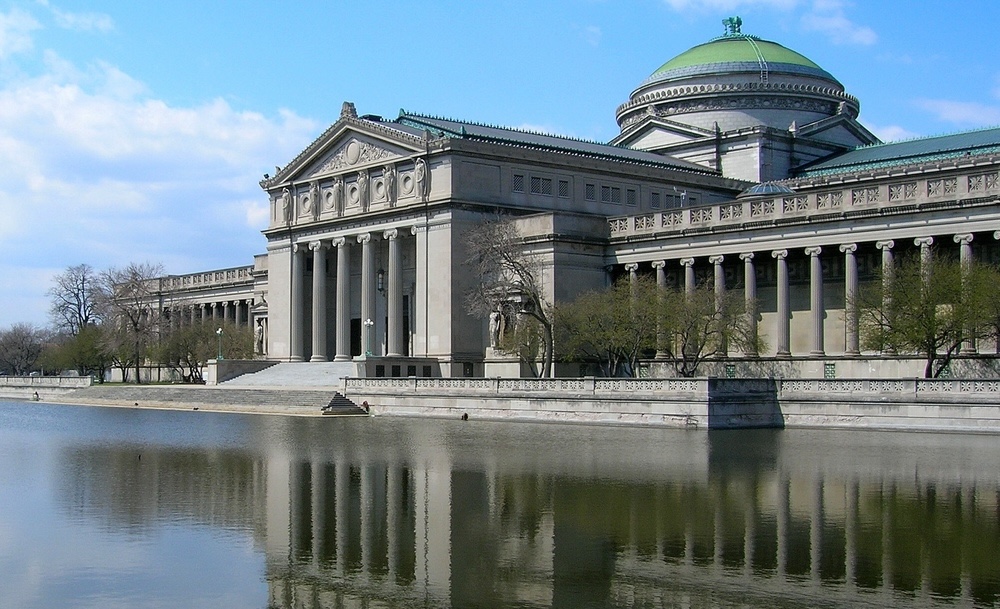Museum of Science and Industry
Chicago Building ID: 102460

Attribution:
Source
Building Info
- Square Footage
- 1,211,750 sqft#1 Largest of MuseumsHigher than 97% of all buildings9x median139,707 sqft3.8x median Museum316,080 sqft
- Built
- 1893
- Primary Property Type
- Museum
- Community Area
- Hyde Park
- Ward
- 5
-
Chicago Energy Rating
- 3.0 / 4
- Owner
2022 Report Card
Debug Full Grade Data
- AvgPercentileLetterGrade: A
- AvgPercentileGrade: 80.0459994681515
- GHGIntensityLetterGrade: B
- GHGIntensityPercentileGrade: 71.45098039215686
- EnergyMixLetterGrade: A
- EnergyMixWeightedPctSum: 59.92020422960051
- EnergyMixPercentileGrade: 85.80127318018268
- SubmittedRecordsLetterGrade: A
- MissingRecordsCount: 0.0
- SubmittedRecordsPercentileGrade: 100.0
Emissions & Energy Information for 2022
- Greenhouse Gas Intensity B
- 5.2 kg CO2e / sqftLower than 72% of all buildings0.8x median6.4 kg CO2e / sqft1.0x median Museum5.4 kg CO2e / sqft
- Total Greenhouse Gas Emissions
- 6,290 tons CO2eHigher than 95% of all buildings7x median885.8 tons CO2e3.3x median Museum1,923.4 tons CO2e
Years Reported
9/9
A

2014
2015
2016
2017
2018
2019
2020
2021
2022
Energy Breakdown
- Fossil Gas Use (aka Natural Gas)
- 25,159,461 kBtuEst. Gas Bill: $300,000 for 2022**Higher than 91% of all buildings4.3x median5,818,399.6 kBtu2.7x median Museum9,191,929.9 kBtu
- Electricity Use
- 37,613,965 kBtuEst. Electric Bill: $1,576,000 for 2022**Higher than 95% of all buildings10x median3,796,376.7 kBtu3.4x median Museum11,096,315.5 kBtu
Energy Mix A
Total Energy Use: 62,773,427 kBTU
View Extra Technical & Historic Info
- Source Energy Usage Intensity
- Not Reported
This data was not reported for this building this year, which likely means a value of zero for this field.
- Site Energy Usage Intensity
- Not Reported
This data was not reported for this building this year, which likely means a value of zero for this field.
Full Historical Data Table for Museum of Science and Industry
| Year |
Overall Grade |
Emissions Intensity Sub-Grade |
Energy Mix Sub-Grade |
Reporting Mix Sub-Grade | GHG Intensity kg CO2e / sqft | GHG Emissions metric tons CO2e | Energy Mix | Electricity Use kBTU | Fossil Gas Use kBTU |
District Steam Use kBTU |
District Chilled Water Use kBTU | Source EUI kBTU / sqft | Floor Area sqft |
Chicago Energy Rating |
|---|---|---|---|---|---|---|---|---|---|---|---|---|---|---|
| 2014 | B | A | C | A | 8.5 | 10,297 | 57%Electricity 43%Fossil Gas 0%Other | 42,942,145 | 31,928,824 | - | - | 139 | 1,211,750 | - |
| 2015 | B | B | B | A | 8.2 | 9,876 | 61%Electricity 39%Fossil Gas 0%Other | 42,097,388 | 27,057,126 | - | - | 132.4 | 1,211,750 | - |
| 2016 | B | C | B | A | 7.6 | 9,171 | 61%Electricity 39%Fossil Gas 0%Other | 42,022,194 | 27,129,610 | - | - | 132.3 | 1,211,750 | - |
| 2017 | B | C | B | A | 7.2 | 8,722 | 60%Electricity 40%Fossil Gas 0%Other | 39,739,453 | 26,129,680 | - | - | 125.5 | 1,211,750 | - |
| 2018 | B | B | A | A | 6.7 | 8,081 | 57%Electricity 43%Fossil Gas 0%Other | 39,197,348 | 29,543,708 | - | - | 116.1 | 1,211,750 | 3.0 |
| 2019 | A | B | A | A | 6.1 | 7,443 | 63%Electricity 37%Fossil Gas 0%Other | 37,596,553 | 22,531,638 | - | - | 106.3 | 1,211,750 | 4.0 |
| 2020 | A | A | A | A | 4.4 | 5,371 | 59%Electricity 41%Fossil Gas 0%Other | 27,931,407 | 19,061,559 | - | - | 81.1 | 1,211,750 | 4.0 |
| 2021 | A | B | A | A | 4.9 | 5,884 | 64%Electricity 36%Fossil Gas 0%Other | 34,007,517 | 19,338,559 | - | - | 95.3 | 1,211,750 | 4.0 |
| 2022 | A | B | A | A | 5.2 | 6,290 | 60%Electricity 40%Fossil Gas 0%Other | 37,613,966 | 25,159,462 | - | - | 108.7 | 1,211,750 | 3.0 |
* Note on Rankings: Rankings and medians are among included buildings, which are those who reported under the Chicago Energy Benchmarking Ordinance for the year 2022, which only applies to buildings over 50,000 square feet.
** Note on Bill Estimates:
Estimates for gas and electric bills are based on average electric and
gas retail prices for Chicago in 2021 and
are rounded. We expect large buildings would negotiate lower rates with
utilities, but these estimates serve as an upper bound of cost and help
understand the volume of energy a building is used by comparing it to
your own energy bills! See our
Chicago Gas & Electric Costs Source
for the original statistics.
Data Source:
Chicago Energy Benchmarking Data